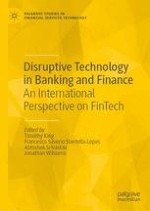2021 | OriginalPaper | Chapter
7. FinTech Cultures and Organizational Changes in Financial Services Providers
Authors : Timothy King, Daniele Angelo Previati
Published in: Disruptive Technology in Banking and Finance
Publisher: Springer International Publishing
Activate our intelligent search to find suitable subject content or patents.
Select sections of text to find matching patents with Artificial Intelligence. powered by
Select sections of text to find additional relevant content using AI-assisted search. powered by
